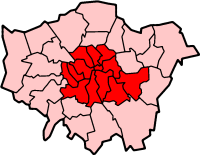Inner London
|
|
Inner London is technically a term for the central part of Greater London, in contrast to Outer London.
It is also a term that is less precisely used to describe the poor areas of Central London outside the City of London, Westminster and Kensington as in: 'poverty/unemployment/good housing/good schooling is a major problem in Inner London'.
| ILEA's Inner London | |
 |
|
| ONS's Inner London | |
| Missing image LondonInnerCensus.png Image:LondonInnerCensus.png |
For the purposes of the Inner London Education Authority, it consisted of Camden, the City, Greenwich, Hackney, Hammersmith and Fulham, Islington, Kensington and Chelsea, Lambeth, Lewisham, Southwark, Tower Hamlets, Wandsworth, Westminster.
These London boroughs, along with North Woolwich, which was ceded to the London Borough of Newham, make up the entirety of the old County of London.
The term is also used in a variety of other contexts with different meanings. The Office for National Statistics and the Census uses the term, including Haringey and Newham in Inner London, but Greenwich in Outer London. This is also used by Eurostat at NUTS level 2.
Generally Inner London phone numbers have the form 020-7xxx-xxxx whilst Outer London ones have 020-8xxx-xxxx. The next range of numbers to be released in London which are 020-3xxx-xxxx will not be split in this way and furthermore numbers in the existing ranges will be allocated throughout London.
The London Borough of Newham is seeking recognition as an Inner London borough for central government grants, as this would have financial benefits for the Borough. It is not currently considered an Inner London Borough as it did not form part of the original pre-1965 County of London.
Inner London is the richest area in the European Union, GDP per capita is £45,540 (€66,761).
Historical population
Please note: Figures here are for the ONS's Inner London (in its 2001 limits), whose land area is 319 km² (123 sq. miles). Figures before 1971 have been reconstructed by the Office for National Statistics based on past censuses in order to fit the 2001 limits. Figures from 1981 onward are midyear estimates (revised as of 2004), which are more accurate than the censuses themselves, known to underestimate the population of London.
1891, April 5/6 4,488,242 1901, March 31/April 1 4,859,558 1911, April 2/3 4,998,237 1921, June 19/20 4,972,870 1931, April 26/27 4,893,261 1939, Midyear estimate 4,364,457 1951, April 8/9 3,679,390 1961, April 23/24 3,492,879 1971, April 25/26 3,031,935 1981, Midyear estimate 2,550,100 1991, Midyear estimate 2,599,300 2001, Midyear estimate 2,859,400 2003, Midyear estimate 2,904,600de:Inner London
